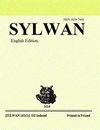Drewno w budownictwie oraz przedmiotach życia codziennego na terenie Kielecczyzny od końca XVII do początku XX wieku
IF 0.5
4区 农林科学
Q4 FORESTRY
引用次数: 0
Abstract
The aim of the study was to research which wood species were used to make constructions and everyday objects in the Świetokrzyski, Rural Town, and Manor sectors of the Ethnographic Park (an open−air museum) in Tokarnia (central Poland). The objects on display are in the natural village environment. Apart from the traditional architecture there are also permanent exhibitions of furnishings belonging to people of different social classes. In all investigated sectors we found thirty five items. Wood species were determined using the macroscopic method. The Ethnographic Park archives contain residual information about wood species. Larch was the most commonly used wood species in the whole area. Other species used in the architecture include oak, pine and fir. Chairs and beds were made from pine and oak. For upright furniture, oak and less often pine were used. The other wood species used in this kind of furniture were larch, ash, beech and walnut. Kitchen utensils were mostly made from pine, poplar, birch, beech and oak. School utensils were made from beech, birch and pine. Oak, beech and birch were used in others items. Wood species used in construction and the production of everyday objects in the Kielce region from the end of the 17 th century to the beginning of the 20 th century. Localization and investigation into others traditional objects in świetokrzyskie voivodeship should be further discussed in the next study. Moreover, maps of tree stands from the end of the 17 th century to the beginning of the 20 th century should be analysed. Consideration of these aspects may help find the reason why larch was the most popular wood species in the Ethnographic Park in Tokarnia.17世纪末至20世纪初基尔切建筑和日常用品中的木材
该研究的目的是研究在Tokarnia(波兰中部)的Świetokrzyski、乡村小镇和人种公园(一个露天博物馆)的庄园部分,哪些木材被用来制作建筑和日常用品。展品均在自然村环境中展出。除了传统的建筑,还有属于不同社会阶层的人的家具的永久展览。在所有被调查的行业中,我们发现了35个项目。采用宏观方法测定木材种类。民族志公园的档案包含了关于木材种类的残留信息。落叶松是整个地区最常用的树种。建筑中使用的其他树种包括橡树、松树和冷杉。椅子和床是用松木和橡木做的。直立式家具则使用橡木,很少使用松木。这种家具使用的其他木材品种有落叶松、白蜡树、山毛榉和胡桃木。厨房用具大多由松树、杨树、桦树、山毛榉和橡树制成。学校用具由山毛榉、桦树和松树制成。橡木、山毛榉和桦木也被用于制作其他物品。从17世纪末到20世纪初,凯尔采地区用于建筑和日常用品生产的木材种类。对świetokrzyskie省内其他传统文物的定位和调查应在下一步的研究中进一步探讨。此外,还应该分析17世纪末至20世纪初的树木分布图。考虑这些方面可能有助于找到落叶松是托卡尼亚民族志公园中最受欢迎的树种的原因。
本文章由计算机程序翻译,如有差异,请以英文原文为准。
求助全文
约1分钟内获得全文
求助全文
来源期刊

Sylwan
农林科学-林学
CiteScore
0.70
自引率
16.70%
发文量
0
审稿时长
1 months
期刊介绍:
SYLWAN jest najstarszym w Polsce leśnym czasopismem naukowym, jednym z pierwszych na świecie. Został założony w 1820 roku w Warszawie. Przyczynił się w znakomity sposób do rozwoju polskiego leśnictwa, służąc postępowi, upowszechnieniu wiedzy leśnej oraz rozwojowi nauki.
 求助内容:
求助内容: 应助结果提醒方式:
应助结果提醒方式:


